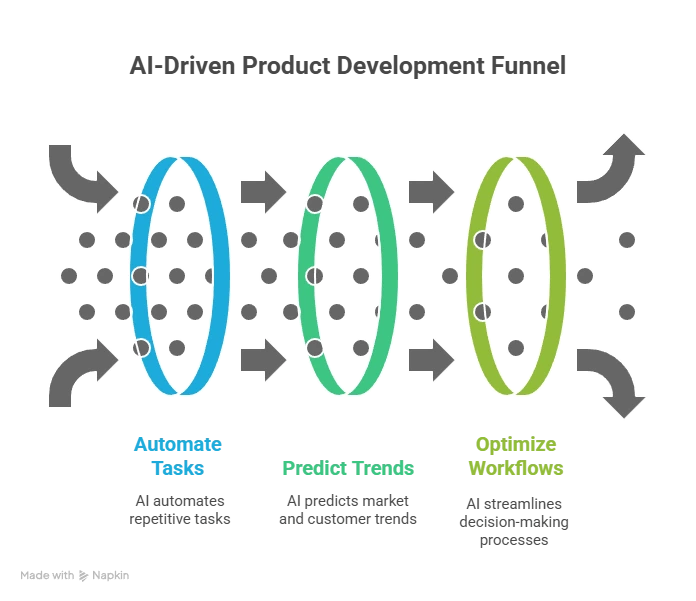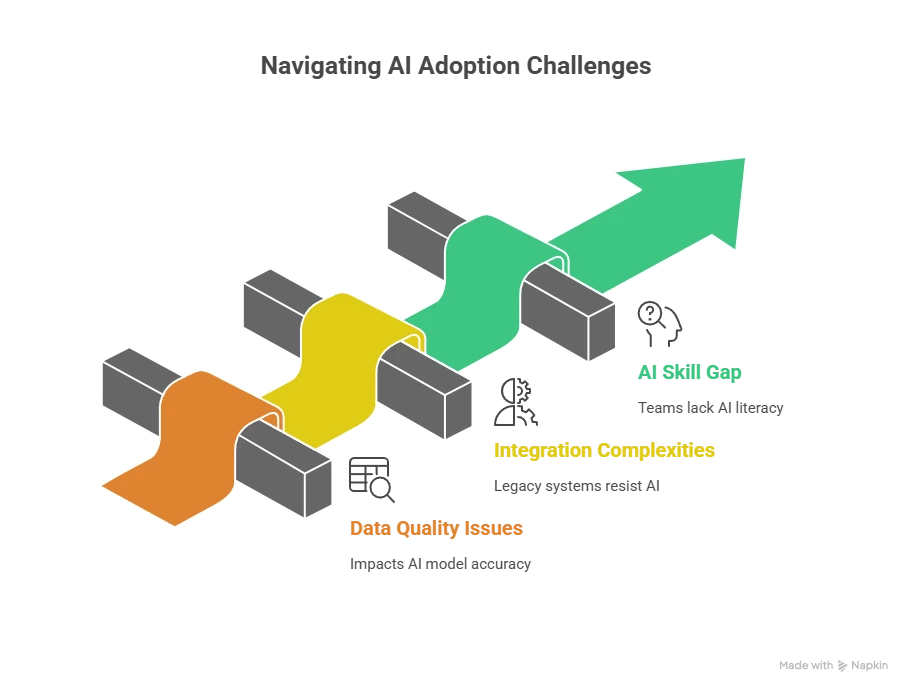In today’s hyper-competitive business landscape, speed is no longer just an advantage—it’s a necessity. Companies that can bring products to market rapidly without compromising quality often dominate their respective industries. Over the past few years, my team and I have experimented with various product development methodologies. The most transformative discovery has been adopting an AI-first approach.
By leveraging Artificial Intelligence (AI) at every stage—from ideation and design to testing and launch—we have consistently shortened product development cycles, increased accuracy, and delivered superior customer experiences. In this blog, I will explain how an AI-first strategy powers lightning-fast product launches, the tools and techniques that have proven effective, and practical steps to implement this approach in your organization.
What Is an AI-First Approach?

An AI-first approach refers to integrating AI and machine learning at the core of business processes, particularly product development. Instead of using AI as an afterthought, we design products and workflows that leverage AI from day one.
This approach enables us to:
-
Automate repetitive tasks: From market research to customer feedback analysis, AI saves countless hours.
-
Predict trends: AI models help us anticipate customer needs and emerging market trends.
-
Optimize workflows: Intelligent automation streamlines decision-making, reducing delays.
By prioritizing AI, we don’t just build products faster—we build smarter products that meet real customer demands.
How AI Accelerates Each Stage of Product Development
1. Ideation and Market Research
In traditional product development, the ideation phase can be slow and error-prone. AI tools like predictive analytics, natural language processing (NLP), and trend forecasting algorithms allow us to analyze large volumes of data from customer reviews, social media, and industry reports in minutes.
For example, we feed AI models with historical sales data, customer sentiment, and competitive analysis. The models identify patterns that humans might miss, highlighting unmet needs and emerging opportunities.
Outcome: Rapid identification of high-potential product ideas.
2. Product Design and Prototyping
AI-powered design tools, including generative design platforms, help create multiple product prototypes simultaneously. Instead of manually iterating over hundreds of designs, AI suggests optimized solutions based on predefined criteria such as cost, performance, and user experience.
We have integrated AI in prototyping tools to simulate real-world scenarios, reducing the time spent on physical prototypes. This not only speeds up the process but also ensures the design aligns with market requirements.
Outcome: Faster iteration cycles and data-driven design decisions.
3. Development and Coding
Software development benefits immensely from AI-driven code generation and debugging tools. For instance, AI-assisted coding platforms can:
-
Suggest code snippets and functions automatically.
-
Detect bugs or security vulnerabilities before testing.
-
Generate unit tests to ensure robust code.
By implementing these AI solutions, our development team spends less time on repetitive coding tasks and more time on strategic enhancements.
Outcome: Reduced coding time and faster development cycles.
4. Testing and Quality Assurance
Quality assurance is often the bottleneck in product launches. AI solves this problem through automated testing frameworks that:
-
Run thousands of test cases in parallel.
-
Predict potential points of failure using historical defect data.
-
Continuously learn from past errors to improve future testing.
This predictive QA approach enables us to release high-quality products with confidence, minimizing post-launch fixes.
Outcome: Shorter testing phases without compromising quality.
5. Launch and Marketing Optimization
AI plays a crucial role even after development is complete. Using machine learning algorithms, we can:
-
Identify the most effective marketing channels for launch campaigns.
-
Personalize content for target audiences in real-time.
-
Predict product adoption rates and adjust inventory accordingly.
These AI-driven insights ensure that the product not only reaches the market faster but also achieves better engagement and adoption rates.
Outcome: A strategic, data-informed launch that maximizes impact.
Core AI Tools We Use
Over the years, we have experimented with several AI technologies. Here are some that have consistently delivered results:
-
Generative AI (like GPT-5) for content creation and ideation.
-
Predictive Analytics for market trend forecasting.
-
Computer Vision for product quality inspection.
-
Robotic Process Automation (RPA) for automating repetitive operational tasks.
-
AI-driven Project Management Tools to predict project delays and optimize resource allocation.
Each of these tools contributes to faster product cycles and more efficient decision-making.
Benefits of an AI-First Product Launch Strategy
-
Speed: AI accelerates every stage of development, from ideation to launch.
-
Cost Reduction: Automated tasks reduce operational costs and resource waste.
-
Data-Driven Decisions: Insights derived from AI models improve strategic planning.
-
Improved Customer Experience: Predictive analysis ensures products meet customer expectations.
-
Competitive Advantage: Companies adopting AI-first strategies consistently outperform competitors in time-to-market metrics.
Common Challenges and How to Overcome Them

While the AI-first approach is transformative, it comes with challenges:
-
Data Quality Issues: AI is only as good as the data it consumes. We invest heavily in cleaning and curating datasets.
-
Integration with Existing Processes: Legacy systems may not support AI integration. We adopt a phased approach to gradually embed AI.
-
Skill Gap: Teams require AI literacy. We conduct workshops and training sessions to ensure everyone understands the AI tools in use.
By proactively addressing these challenges, we ensure that AI adoption accelerates rather than hinders product launches.
Real-World Impact of AI-First Launches
In our experience, adopting an AI-first approach has cut our product development cycles by 40–50%. For instance, what used to take six months now takes three, without compromising quality or customer satisfaction.
Moreover, AI insights have helped us:
-
Identify niche markets quickly.
-
Reduce product return rates by predicting user pain points.
-
Optimize resource allocation, reducing overstaffing and unnecessary expenses.
The combination of speed, precision, and intelligence is what gives AI-first companies a clear competitive edge.
Frequently Asked Questions (FAQs)
1. What is an AI-first approach in product development?
An AI-first approach integrates AI at the core of the product lifecycle—from ideation to launch—enabling faster, smarter, and more efficient development.
2. How does AI shorten product launch timelines?
AI automates repetitive tasks, predicts market trends, optimizes workflows, and accelerates testing, which collectively reduces development time.
3. Which AI tools are essential for rapid product launches?
Key tools include generative AI (for ideation), predictive analytics (for market forecasting), AI-driven QA platforms (for testing), and AI-assisted project management tools.
4. Can small businesses adopt an AI-first strategy?
Yes. Cloud-based AI solutions and scalable automation tools allow small businesses to leverage AI without large upfront investments.
5. Does AI compromise product quality when speeding up development?
No. AI enhances quality by automating error detection, predicting failures, and providing data-driven insights to improve designs and features.
Resource Center
These aren’t just blogs – they’re bite-sized strategies for navigating a fast-moving business world. So pour yourself a cup, settle in, and discover insights that could shape your next big move.
How Serious Are the New React & Next.js RCE Vulnerabilities?
The JavaScript ecosystem woke up to a major security alarm this week. Two newly disclosed vulnerabilities — CVE-2025-55182 (React) and CVE-2025-66478 (Next.js) — expose millions of applications to unauthenticated [...]
How can businesses integrate ChatGPT-style services into their existing workflows?
In today’s competitive landscape, organisations are under constant pressure to innovate, accelerate delivery, and streamline operations. As businesses re-evaluate traditional processes, ChatGPT-style AI services are emerging as one of [...]
Are AWS Frontier AI Agents Redefining the Future of Autonomous Software Development?
In our two decades of engineering experience, we’ve witnessed dozens of technological waves—cloud adoption, container orchestration, serverless evolution, full-stack automation, LLM assistance, and more. But every once in a [...]

